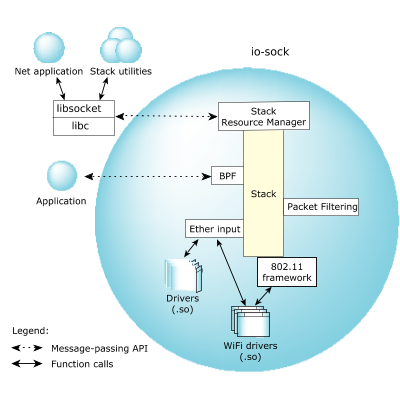The io-sock network stack is very similar in architecture to other component subsystems inside of the QNX Neutrino RTOS.
At the bottom layer are drivers that provide the mechanism for passing data to, and receiving data from, the hardware. The drivers hook into a multi-threaded packet-processing layer that passes them to the appropriate multi-threaded IP and upper-layer protocol-processing components (TCP and UDP).
In QNX Neutrino, a resource manager forms a layer on top of the stack. The resource manager acts as the message-passing intermediary between the stack and user applications. It provides a standardized type of interface involving open(), read(), write(), and ioctl() that uses a message stream to communicate with networking applications. Networking applications written by the user link with the socket library. The socket library converts the message-passing interface exposed by the stack into a standard BSD-style socket layer API, which is the standard for most networking code today (see “Socket API”).
In addition to the socket-level API, there are also other, programmatic interfaces into the stack that are provided for filtering to occur.
 Figure 1. A detailed view of the io-sock architecture.
Figure 1. A detailed view of the io-sock architecture.At the driver layer, there are interfaces for Ethernet traffic (used by all Ethernet drivers), and an interface into the stack for 802.11 management frames from wireless drivers. You can load drivers (built as DLLs for dynamic linking and prefixed with devs-*) into the stack using the io-sock option -d.
The stack also includes hooks for packet filtering. The main interfaces supported for filtering are:
- Berkeley Packet Filter (BPF) interface
- A socket-level interface that lets you read and write, but not modify or block, packets, and that you access by using a socket interface at the application layer (see http://en.wikipedia.org/wiki/Berkeley_Packet_Filter). This is the interface of choice for basic, raw packet interception and transmission and gives applications outside of the stack process domain access to raw data streams.
- Packet Filter (PF) interface
- A read/write/modify/block interface that gives complete control over which packets are received by or transmitted from the upper layers.
For more information, see “Packet Filtering.”